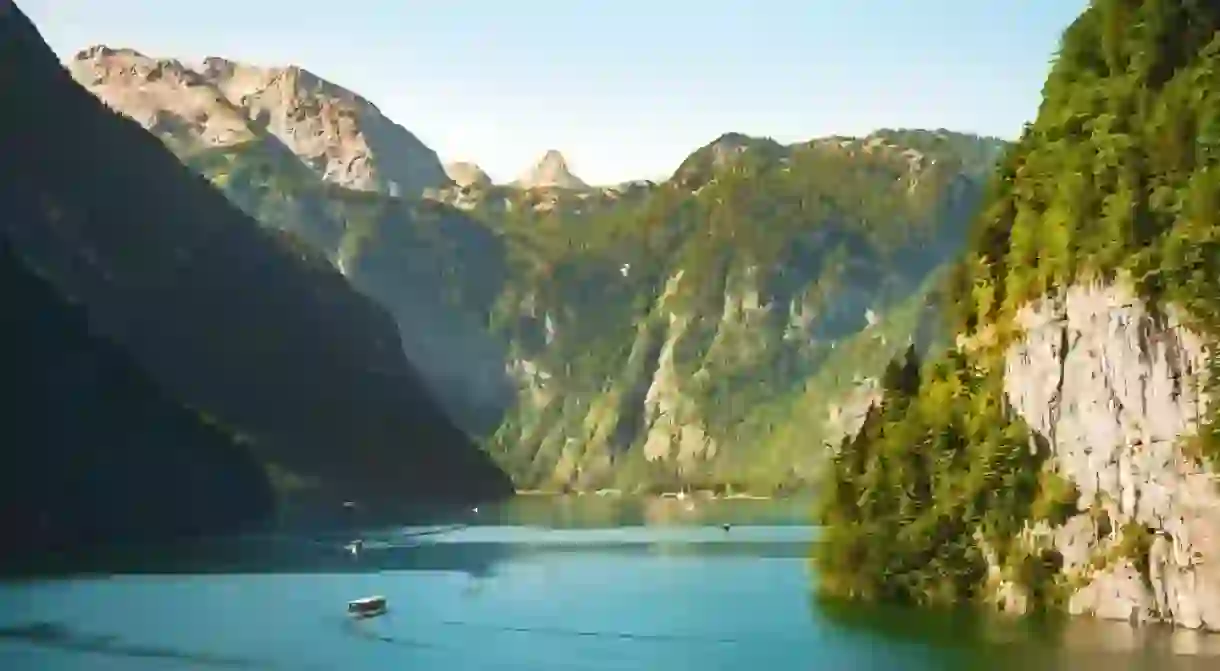The Best Things to See and Do in Berchtesgaden

The quaint German mountain town of Berchtesgaden, close to the Austrian border, basks in the remarkable beauty of the Bavarian Alps. But in contrast to the mountains and mirror lakes, a sinister history lingers – remnants of the Nazi years, including dark-tourism locations such as the Eagle’s Nest. Here’s our guide to the can’t-miss attractions.
Take a boat trip on Königssee
Natural Feature
Set sail onto one of the most beautiful lakes in Germany, the Königssee. This 8km-long, 1,250m-wide crystal-clear natural lake is formed by glacial waters in the southeast of Berchtesgadener Land. Towering mountain peaks are reflected on its mirror-like water, which has been kept clean and pristine thanks to a ban on any boat that’s not electric. Boat tours usually allow you to get off and explore the photogenic St Bartholomew’s Church.
Glimpse Nazi history at the Eagle's Nest
Building, Memorial

The Kehlsteinhaus (Eagle’s Nest) stands on a majestic ridge 1,834m above ground – but the building’s history is a dark one. It was commissioned by the Nazis in 1937, as a place to discuss and draw out their regime’s plans. It’s an eerie feeling to take the lift once used by Hitler, and to see the meeting rooms through plate-glass windows. Information about the building’s past is relayed along the wall of what is now a beer terrace.
Ride on the salt-mine train at Salzbergwerk
Architectural Landmark, Museum
The salt mine of Berchtesgaden Salzbergwerk, which has been operating since 1517, takes you on a fascinating journey into the world of so-called white gold. Only accessible by guided tour, you’ll learn the history and process of salt mining over the course of an hour or so. The experience is far from dry – you’re given traditional miners’ overalls before riding a train deep into the mine, taking a raft across a salt lake and slipping down an old industry slide.
Take the gondola up Jenner Mountain
Natural Feature

The highest peak in Berchtesgaden, Jenner Mountain delivers a panorama of almost 100 snow-clad peaks across the German and Austrian Alps. The journey to the summit is by two-person gondola carriages (Jennerbahn), which sail over dark forests, Alpine lakes and rugged mountain terrain. The words of the Bavarian poet Ludwig Ganghofer – “He, whom God loves, is dropped into this Land!” – might resonate with you as you reach the top. If you’re looking for adventure, paragliding, hang-gliding, skiing and snowboarding are all available here.
Shoot down the Sommerrodelbahn Slide
Amusement Park
In summer, there’s one way to take in the Alpine scenery that beats all others – by riding the 600-metre (1,969-foot) luge. You’ll whizz downhill on a metal chute while sitting on a small cart that has a brake in the middle, which allows you to control your own speed – note that under-eights aren’t allowed to ride alone. It’s not something you can do just once, so buy a few rides upfront and go down again and again.
Visit St Bartholomew's Church
Church

A pilgrimage destination on the lakeshore of Königssee, St Bartholomew’s (Bartholomae) Church has a postcard-perfect spot at the foot of mist-shrouded Alps. It’s made even more striking by its baroque architecture, with red-painted onion domes on top of a pretty stucco building. The church is accessible by boat – it’s located on the Hirschau peninsula at the lake’s west bank – or by a long mountain hike.
Walk across Wimbachklamm Gorge
Natural Feature
The Wimbachklamm Gorge is an eroded section of the Wimbach Valley, carved out by the force of the River Wimbach over thousands of years. You’ll hear the river before you see it – it flows underground before erupting with a roar and crashing down a waterfall into the gorge. You can see this natural wonder on the wooden walkways, accessible from the foot of Mount Watzmann.
Drive along Rossfeld Panoramastrasse
Architectural Landmark
A drive along Rossfeld Panoramastrasse is the highlight of any tour of Berchtesgaden. This serpentine road, hugging the cliffs and winding between the pines, is like something from an Alpine storybook. It’s spectacular whatever the season – the dazzling green panorama of summer is transformed into a snowy wonderland come winter. Shooting off the road are hiking trails of varying difficulty, while higher up you’ll find skiing pistes.
Take in the history of Dokumentation Obersalzberg
Museum
Dokumentation Obersalzberg is a museum of 950 documents, photographs, audio clips, videos and maps depicting Nazi rule and the horrors of the Holocaust. It also traces the morphing of Obersalzberg from a tourist destination to Hitler’s stronghold and back again. It had been the place of Hitler’s holiday home since 1923, and was then expanded to become the second seat of government after Berlin. The museum also hosts special exhibitions and lectures from time to time.
See the German War Graves
Cemetery
The German War Graves are another reminder of the ugliness of war that once existed alongside this region’s beauty. Townsfolk with no physical remains of their relatives often erected their own memorials and tombstones in existing cemeteries, such as this one at the local Franciscan church. Around the cemetery are 910 graves of German soldiers and 55 graves of German civilians who were killed during World War II – most of which are empty.













